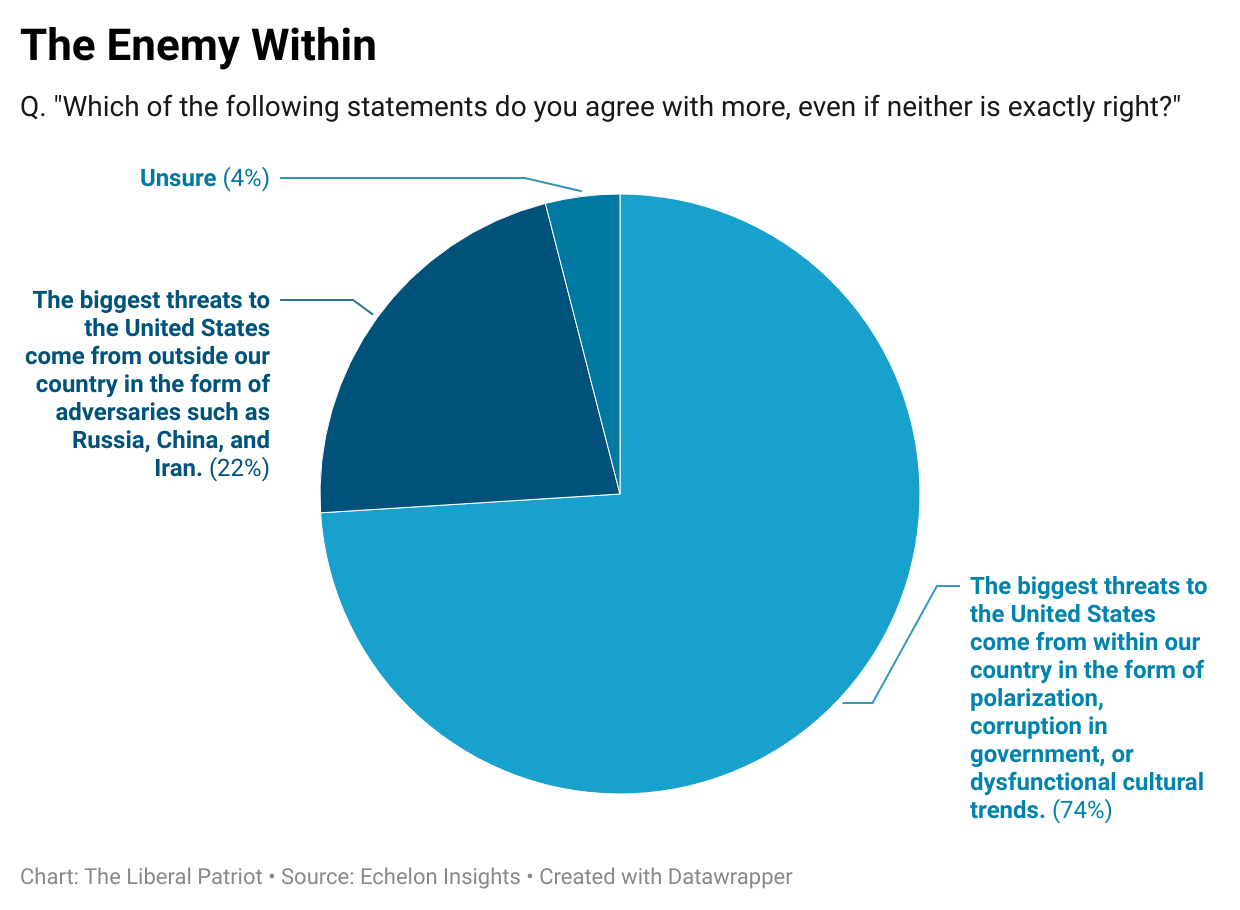In a world full of bad actors and rogue nations, Americans don’t seem too worked up about external threats. In fact, when TLP’s friends at Echelon Insights asked whether the biggest threats to the United States come from “outside our country in the form of adversaries such as Russia, China, and Iran” or instead from “within our country in the form of polarization, corruption in government, or dysfunctional cultural trends,” roughly three-quarters of American voters said our biggest threats are internal.
Numbers this high almost always reflect basic consensus across demographic lines. Accordingly, around seven in ten Americans, regardless of their gender, age, education, race/ethnicity, or income, agree that our biggest threats are internal, not external. Similarly, in terms of partisanship, the difference is more a matter of degree rather than any serious disagreement about the location of threats to the nation: 63 percent of Republicans, 79 percent of independents, and 82 percent of Democrats believe our nation’s biggest threats are internal.
These findings are perhaps a testament to Americans’ ongoing belief in the military and economic might of the United States in relation to countries like Russia, China, or Iran. Despite the saber rattling and threats from the anti-American axis, Americans themselves don’t feel all that threatened by it—at least for now. This seems like a genuine plus for the country.
In contrast, the three components of the internal threats cited in this question—polarization, corruption, and cultural dysfunction—clearly worry Americans of different stripes, probably in different ways. For instance, those focused more on politics undoubtedly notice the lack of comity, or common purpose, among Democrats and Republicans and worry about the internal cohesion of the country and the possibility of increased political violence. Can we really make it long-term with half the country hating the other half because of their political views? Can elected officials really rise to the occasion and put aside their differences to help fix our broken schools, repair decrepit infrastructure, and ensure that all Americans—regardless of where they live or who they vote for—have decent work options, safe neighborhoods for their families, basic health care, and secure retirements? The answer right now is clearly no.
Others less focused on politics perhaps look at trends around crime, drug use, anti-social behaviors, broken families, social media saturation, and declining ethical and moral standards across age groups as major causes for alarm. Can our people really reach their greatest potential living in unsafe environments with low social trust, heightened fear and anxiety, chronic stress and other health problems, and diminished expectations in life? Can our nation really compete with the likes of China when so many of us believe our own culture is completely sick or broken and that our elected officials are all corrupt? Again, the answer right now is clearly no, thus explaining the findings above.
It's easy for those who are partisan warriors or who are economically comfortable and successful to dismiss the concerns of Americans about internal threats as overblown, “fake news,” or mass paranoia and neurosis. But this is a core part of the problem.
Alternatively, our leadership class in politics, business, education, and the media could take these concerns more seriously and do something concrete to ratchet down the polarization, end the corruption, and improve America’s social and political culture rather than abusing their power to exacerbate these trends and make things worse.
External threats we can surely handle with our military supremacy, economic power, and geographical advantages. Internal threats, however, will require a wholesale change in leadership and the values these leaders and other citizens bring to major institutions of American life.





Since this Substack is about Democrats, I will discuss Democrats though I could and have said similar about Republicans. As much as leadership is dysfunctional, the problem is the base or at least the internet dwelling portion of it. I spent some time reading comments at Heather Cox Richardson's place. Since she has arguably the most popular Substack, that is a decent way to take the temperature. The first piece was about Trump's performance at the UN. As expected, the essay was hostile but the comments were over the top, foam at the mouth stuff. Monoculture and focused solely on the Bad Orange Man. The single attempt to define any position for Democrats was an anti-capitalist comment. Next, I picked what I thought would be a relatively non-political topic, Memorial Day. Indeed, the essay met that expectation. But the comments were about executing Confederates and the evils of pickup trucks. It was an order of magnitude more extreme than comment threads in the NYT. Since I have encountered similar in meatspace, I don't think this is just the internet. I don't know how you fix this.
This essay in a nutshell is why I read the Liberal Patriot.
"Internal threats, however, will require a wholesale change in leadership and the values these leaders and other citizens bring to major institutions of American life." That about says it all. I keep waiting for some leader to emerge, and he or she might well appear here first.
So far our leaders are desperate to cling to power, and to do that they court the money of the wealthy, Trump has done nothing more than add a zero or two to the numbers involved. Divisions and hatreds make us more malleable.
I'd not recommend the comments on Letter from America. Cesspool. I like Matt Yglesias' Slow Boring better when looking for the corrupt center of the Democratic Party. Matt is very agreeable, and there is plenty there that is not upsetting except that he can't fathom the working class, but that then is the Democratic Party of the 2020s. I pay money for none of them.